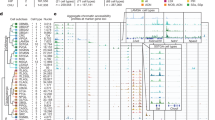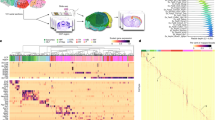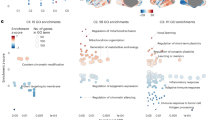Abstract
Neuroanatomically precise, genome-wide maps of transcript distributions are critical resources to complement genomic sequence data and to correlate functional and genetic brain architecture. Here we describe the generation and analysis of a transcriptional atlas of the adult human brain, comprising extensive histological analysis and comprehensive microarray profiling of ∼900 neuroanatomically precise subdivisions in two individuals. Transcriptional regulation varies enormously by anatomical location, with different regions and their constituent cell types displaying robust molecular signatures that are highly conserved between individuals. Analysis of differential gene expression and gene co-expression relationships demonstrates that brain-wide variation strongly reflects the distributions of major cell classes such as neurons, oligodendrocytes, astrocytes and microglia. Local neighbourhood relationships between fine anatomical subdivisions are associated with discrete neuronal subtypes and genes involved with synaptic transmission. The neocortex displays a relatively homogeneous transcriptional pattern, but with distinct features associated selectively with primary sensorimotor cortices and with enriched frontal lobe expression. Notably, the spatial topography of the neocortex is strongly reflected in its molecular topography—the closer two cortical regions, the more similar their transcriptomes. This freely accessible online data resource forms a high-resolution transcriptional baseline for neurogenetic studies of normal and abnormal human brain function.
This is a preview of subscription content, access via your institution
Access options
Subscribe to this journal
Receive 51 print issues and online access
$199.00 per year
only $3.90 per issue
Buy this article
- Purchase on SpringerLink
- Instant access to full article PDF
Prices may be subject to local taxes which are calculated during checkout






Similar content being viewed by others
References
Lein, E. S. et al. Genome-wide atlas of gene expression in the adult mouse brain. Nature 445, 168–176 (2007)
Diez-Roux, G. et al. A high-resolution anatomical atlas of the transcriptome in the mouse embryo. PLoS Biol. 9, e1000582 (2011)
Baldock, R. A. et al. EMAP and EMAGE: a framework for understanding spatially organized data. Neuroinformatics 1, 309–325 (2003)
Kang, H. J. et al. Spatio-temporal transcriptome of the human brain. Nature 478, 483–489 (2011)
Colantuoni, C. et al. Temporal dynamics and genetic control of transcription in the human prefrontal cortex. Nature 478, 519–523 (2011)
Markou, A., Chiamulera, C., Geyer, M. A., Tricklebank, M. & Steckler, T. Removing obstacles in neuroscience drug discovery: the future path for animal models. Neuropsychopharmacology 34, 74–89 (2009)
Evans, A. C. et al. Anatomical mapping of functional activation in stereotactic coordinate space. Neuroimage 1, 43–53 (1992)
Zeng, H. et al. Large-scale cellular-resolution gene profiling in human neocortex reveals species-specific molecular signatures. Cell 149, 483–496 (2012)
Bentivoglio, M. & Morelli, M. in Handbook of Chemical Neuroanatomy. Dopamine (eds Dunnett, S. B., Bentivoglio, M., Bjorklund, A. & Hokfelt, T. ) Ch. I 1–107 (Elsevier, 2005)
Hurd, Y. L. & Hall, H. in Handbook of Chemical Neuroanatomy. (Dopamine) (eds Dunnett, S.B., Bentivoglio, M., Bjorklund, A., & Hokfelt, T. ) Ch. IX 525–571 (Elsevier, 2005)
Johnson, M. B. et al. Functional and evolutionary insights into human brain development through global transcriptome analysis. Neuron 62 494–509 S0896–6273(09)00286–4 (2009)
Bayes, A. et al. Characterization of the proteome, diseases and evolution of the human postsynaptic density. Nature Neurosci. 14, 19–21 (2011)
Huang da, W. Sherman, B. T. & Lempicki, R. A. Systematic and integrative analysis of large gene lists using DAVID bioinformatics resources. Nature Protocols 4, 44–57 (2009)
Hof, P. R., Nimchinsky, E. A. & Morrison, J. H. Neurochemical phenotype of corticocortical connections in the macaque monkey: quantitative analysis of a subset of neurofilament protein-immunoreactive projection neurons in frontal, parietal, temporal, and cingulate cortices. J. Comp. Neurol. 362, 109–133 (1995)
Bergles, D. E., Roberts, J. D., Somogyi, P. & Jahr, C. E. Glutamatergic synapses on oligodendrocyte precursor cells in the hippocampus. Nature 405, 187–191 (2000)
Zhang, B. & Horvath, S. A general framework for weighted gene co-expression network analysis. Stat. Appl. Genet. Mol. Biol. 4, (2005)
Horvath, S. et al. Analysis of oncogenic signaling networks in glioblastoma identifies ASPM as a molecular target. Proc. Natl Acad. Sci. USA 103, 17402–17407 (2006)
Oldham, M. C. et al. Functional organization of the transcriptome in human brain. Nature Neurosci. 11, 1271–1282 (2008)
Miller, J. A., Horvath, S. & Geschwind, D. H. Divergence of human and mouse brain transcriptome highlights Alzheimer disease pathways. Proc. Natl Acad. Sci. USA 107, 12698–12703 (2010)
Langfelder, P., Luo, R., Oldham, M. C. & Horvath, S. Is my network module preserved and reproducible? PLoS Comput. Biol. 7, e1001057 (2011)
Harrow, J. et al. GENCODE: producing a reference annotation for ENCODE. Genome Biol. 7, (suppl. 1)1–9 (2006)
Amaral, D. G. & Insausti, R. in The Human Nervous System (ed. Paxinos, G. ) 771–755 (Academic, 1990)
Bernard, A. et al. Transcriptional architecture of the primate neocortex. Neuron 73, 1083–1099 (2012)
Hawrylycz, M. et al. Digital atlasing and standardization in the mouse brain. PLoS Comput. Biol. 7, e1001065 (2011)
Shattuck, D. W. et al. Construction of a 3D probabilistic atlas of human cortical structures. Neuroimage 39, 1064–1080 (2008)
Mortazavi, A., Williams, B. A., McCue, K., Schaeffer, L. & Wold, B. Mapping and quantifying mammalian transcriptomes by RNA-Seq. Nature Methods 5, 621–628 (2008)
Ameur, A. et al. Total RNA sequencing reveals nascent transcription and widespread co-transcriptional splicing in the human brain. Nature Struct. Mol. Biol. 18, 1435–1440 (2011)
DeFelipe, J. & Jones, E. G. Cajal on the Cerebral Cortex: an Annotated Translation of the Complete Writings (Oxford Univ. Press, 1988)
Zilles, K. et al. Architectonics of the human cerebral cortex and transmitter receptor fingerprints: reconciling functional neuroanatomy and neurochemistry. Eur. Neuropsychopharmacol. 12, 587–599 (2002)
Felleman, D. J. & Van Essen, D. C. Distributed hierarchical processing in the primate cerebral cortex. Cereb. Cortex 1, 1–47 (1991)
Belgard, T. G. et al. A transcriptomic atlas of mouse neocortical layers. Neuron 71, 605–616 (2011)
Voineagu, I. et al. Transcriptomic analysis of autistic brain reveals convergent molecular pathology. Nature 474, 380–384 (2011)
Herculano-Houzel, S. The human brain in numbers: a linearly scaled-up primate brain. Front. Hum. Neurosci. 3, 31 (2009)
Douglas, R. J. & Martin, K. A. Neuronal circuits of the neocortex. Annu. Rev. Neurosci. 27, 419–451 (2004)
Hosack, D. A., Dennis, G., Jr, Sherman, B. T., Lane, H. C. & Lempicki, R. A. Identifying biological themes within lists of genes with EASE. Genome Biol. 4, R70 (2003)
Acknowledgements
We wish to thank the Allen Institute founders, P. G. Allen and J. Allen, for their vision, encouragement, and support. We express our gratitude to past and present Allen Institute staff members R. Adams, K. Aiona, A. Alpisa, J. Arnold, C. Bennet, K. Brouner, S. Butler, E. Byrnes, S. Caldejon, J. Campiche, A. Carey, J. Chen, C. Copeland, C. Cuhaciyan, T. Desta, N. Dotson, S. Faber, T. Fliss, E. Fulfs, G. Gee, T. Gilbert, L. Gourley, G. Gu, J. Heilman, N. Ivanov, K. Keyser, A. Kriedberg, J. Laoenkue, F. Lee, S. Levine, L. Luong, N. Mastan, N. Mosqueda, E. Mott, N. Motz, D. Muzia, K. Ngo, A. Oldre, E. Olson, J. Parente, J. Phillips, L. Potekhina, T. Roberts, K. Roll, D. Rosen, M. Sarreal, S. Shapouri, N. Shapovalova, C. Simpson, D. Simpson, M. Smith, N. Stewart, K. Sweeney, A. Szafer, L. Velasquez, U. Wagley, W. Wakeman, C. White and B. Youngstrom for their technical assistance. We thank C. Long for mechanical engineering contract work. We thank R. Gullapalli, A. McMillan and R. Morales for post-mortem magnetic resonance imaging and radiology interpretation of MR data; J. Cottrell, M. Davis, R. Johnson, K. Moraniec, R. Vigorito, A. Weldon and the NICHD Brain and Tissue Bank for Developmental Disorders for tissue acquisition and processing; J. Davis for donor coordination; F. Mamdani, M. Martin, E. Moon, L. Morgan, B. Rollins and D. Walsh for tissue processing and psychological autopsy (DW); D. Patel for magnetic resonance imaging; and J. Sonnen for consultation on tissue microneuropathology. We also thank the External RNA Controls Consortium (ERCC), the US National Institute of Standards (NIST) and Technology, and M. Salit for access to ERCC transcripts during Phase V testing. We are grateful to Beckman Coulter Genomics (formerly Cogenics) and their staff P. Hurban, E. Lobenhofer, K. Phillips, A. Rouse and S. Beaver for microarray data generation and design of the custom Agilent array. We also wish to thank the Allen Human Brain Atlas Advisory Council members D. Geschwind, R. Gibbs, P. Hof, E. Jones, C. Koch, C. Saper, L. Swanson, A. Toga and D. Van Essen for their scientific guidance and dedication to the successful execution of this project. The project described was supported in part by Grant Numbers 1C76HF15069-01-00 and 1 1C76HF19619-01-00 from the Department of Health and Human Services Health Resources and Services Administration Awards and its contents are solely the responsibility of the authors and do not necessarily represent the official views of the Department of Health and Human Services Health Resources and Services Administration Awards. S.G.N.G and L.V.L. were supported by the MRCD, Wellcome Trust and European Union Seventh Framework Programme under grants 241498 EUROSPIN, 242167 SynSys, and 241995 GENCODYS Projects.
Author information
Authors and Affiliations
Contributions
A.R.J., A.L.G.-B., E.H.S. and K.A.S. contributed significantly to overall project design. A.L.G.-B., E.H.S., K.A.S., A.E. and P.W. managed the tissue and sample processing in the laboratory. D.B., A.F.B., R.A.D., J.G., B.W.G., R.E.H., M.K., T.A.L., P.D.P., S.E.P., M.R., J.J.R. and B.E.S. contributed to tissue and sample processing. E.H.S. and Z.L.R. contributed to establishing the tissue acquisition pipeline. P.M.C., B.D.D., D.R.F., L.L., P.A.S., M.P.V. and H.R.Z. contributed to tissue acquisition and MR imaging. Z.L.R., A.B., M.M.C., N.D., A.J., J.M.J., E.T.L., S.C.S. and P.R.H. contributed to protocol development. S.D., J.M.J., C.R.S. and D.W. provided engineering support. A.L.G.-B., R.A.D., P.D.P., J.G.H., J.A.Mo., J.J.R. and B.E.S. contributed to the neuroanatomical design and implementation. L.N. and C.D. managed the creation of the data pipeline, visualization and mining tools. L.N., C.D. and C.C.O. contributed to the overall online product concept. L.N., C.A., M.C., J.C., T.A.D., D.F., Z.H., C.La., Y.L. and A.J.S. contributed to the creation of the data pipeline, visualization and mining tools. M.J.H., E.S.L., J.A.Mi., D.H.G., L.N.L., C.F.B., S.M.Sm., S.G.N.G., A.LG.-.B., E.H.S., K.A.S., A.B., D.B., V.F., J.G., D.R.H., S.H., C.Le., J.S., S.M.Su., P.R.H. and C.K. contributed to data analysis and interpretation. A.R.J. supervised the overall project, and the manuscript was written by M.J.H. and E.S.L. with input from other authors.
Corresponding author
Ethics declarations
Competing interests
The authors declare no competing financial interests.
Supplementary information
Supplementary Methods
This file contains Supplementary Methods 1-3 (see pages 1-2 for details), which describe in detail the methodology of tissue preparation, data generation and data analysis techniques utilized for both the project and the manuscript. (PDF 2375 kb)
Supplementary Information
This file contains Supplementary Figures 1-14 and legends for Supplementary Tables 1-10. (PDF 3460 kb)
Supplementary Tables
This file contains Supplementary Tables 1-10 (see Supplementary Information file for legends). (ZIP 19331 kb)
Rights and permissions
About this article
Cite this article
Hawrylycz, M., Lein, E., Guillozet-Bongaarts, A. et al. An anatomically comprehensive atlas of the adult human brain transcriptome. Nature 489, 391–399 (2012). https://doi.org/10.1038/nature11405
Received:
Accepted:
Published:
Issue Date:
DOI: https://doi.org/10.1038/nature11405
This article is cited by
-
Divergent suicidal symptomatic activations converge on somato-cognitive action network in depression
Molecular Psychiatry (2024)
-
Parkinson’s disease and schizophrenia interactomes contain temporally distinct gene clusters underlying comorbid mechanisms and unique disease processes
Schizophrenia (2024)
-
Structural connectome architecture shapes the maturation of cortical morphology from childhood to adolescence
Nature Communications (2024)
-
Convergent and divergent genes expression profiles associated with brain-wide functional connectome dysfunction in deficit and non-deficit schizophrenia
Translational Psychiatry (2024)
-
Spatial correspondence among regional gene expressions and gray matter volume loss in multiple sclerosis
Molecular Psychiatry (2024)



